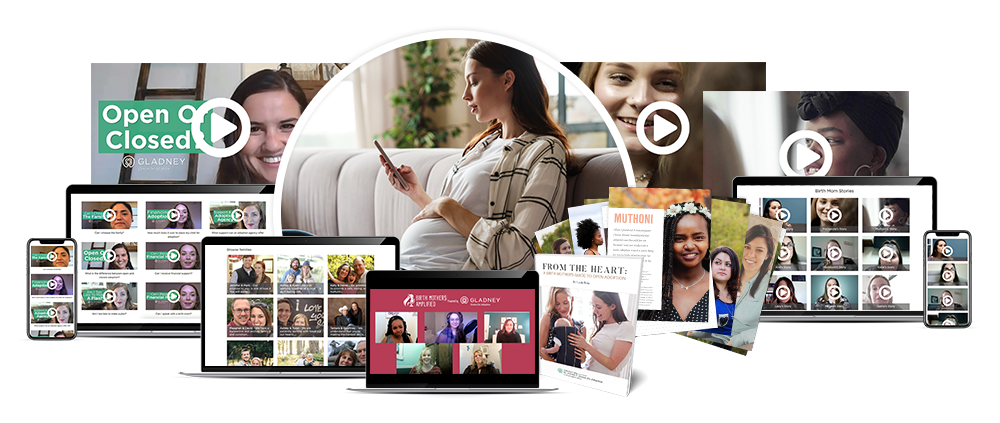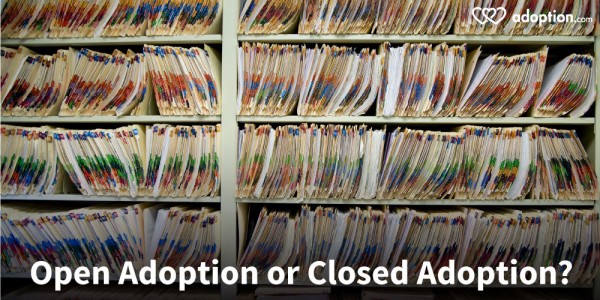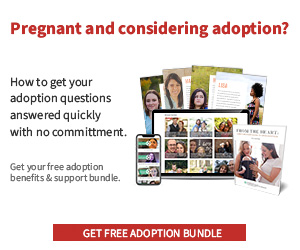The first thing you need to understand is what open vs. closed adoption means. An open adoption is one where you have continuing communication between the birth parents and the adoptive parents. This can be done in varying degrees from face-to-face meetings to just providing photos and written updates. In open adoptions, you generally know the first and last names of the birth parents, and likewise, they know the first and last names of the adoptive parents. The adopted child can also have a much easier time getting information about her or his birth family’s medical history when reaching adulthood. If lines of communication are somehow lost throughout the years, the adopted child will have a much easier time locating her birth family should she wish to do so.
A closed adoption is one where no identifying information is provided by either side. There is no ongoing communication or updates between the birth parents and the adoptive parents. Typically, no names beyond first names are shared. Only basic family history of the birth parents is provided.
However, some states are open adoption states. What this means is that, in the future, when the adopted child becomes an adult, he can have access to information regarding his adoption. Open adoption can mean different things to different states. Some open adoption states only provide non-identifying information. Some provide access to all information. As of 2016, nine states have full access to information for adult adoptees. They are Alabama, Alaska, Colorado, Hawaii, Kansas, Maine, New Hampshire, Rhode Island (for those over age 25), and Oregon. Check the laws of your state to know the current status of its open adoption laws.
There are many ways to set up an open adoption. You can have a fully open adoption where all information is shared, and you can have ongoing contact with all parties. It will be up to all parties (birth and adoptive parents) concerning how much contact there is. Most, if not all, open adoption agreements are not legally enforceable. The adoptive parents have their adopted child first and foremost in mind when they make changes in the open adoption agreement. Visits can be stopped if the adoptive parents believe it is no longer in the best interest of their adopted child.
On the other hand, it can also be the birth mother or father who makes changes. As they move on with their lives, having a close connection with their birth child may not be something they want to maintain. This doesn’t necessarily mean they have no interest or no longer have a love for the child. Birth parents and adoptive parents need to remember that open adoption agreements are constantly changing.
An example of this is my own experience as an adoptive mother. We had an open adoption with our first adopted child. This adoption was a private adoption through an attorney. Names and addresses were shared; however, we didn’t opt for ongoing visits. Our daughter’s maternal birth grandmother did visit on one occasion just to reassure herself that all was well. We faithfully sent monthly photos and updates of our little girl. But, one day, her birth mother got married, moved without providing a forwarding address, and communication stopped until our daughter became an adult, and her half-sister reached out. We chose to respect her birth mother’s decision to move on with her life and did not actively seek to find her. She always knew where we were as our address didn’t change, so we felt content that should her situation change, she’d reach out to us.
You can also opt for a semi-open adoption where there is limited communication between the birth parents and the adoptive parents. There can be an exchange of photos and updates by mail or email. Sometimes, the photos and letters go through a third party. However, semi-open adoption does not necessarily mean there are an exchange of names and/or addresses.
An example of this is the adoption of our second child, a baby boy. We went through an adoption agency for his adoption. At the time, our state was a closed adoption state. This meant that (through the agency) if we chose a closed adoption, no identifying information would be available to any party. We had the option to provide that information, but then the adoption would have become an open adoption. We agreed to provide updates and photos of our adopted son by sending them to the adoption agency. The agency then forwarded these updates to the birth mother. For reasons that I will cover later, we chose to discontinue these updates when our son was around 4 years old.
In a closed adoption, there is no contact with the birth parents before, during, or after the birth of the child. For the most part, this is how adoptions were handled until probably sometime in the 1980s. It became clear that some contact, if not completely open contact, was beneficial to all parties involved. Medical history was more easily obtained. Having ongoing updates and photos was wonderful for the birth parents. Such an agonizing decision for birth parents to place a child for adoption might be mitigated by seeing photos of a smiling, happy, healthy child. When adoptees reached adulthood, finding information about their birth family was much more easily obtained. I firmly believe that there should be no secrets, but that’s just my opinion as an adoptive parent.
WHICH ONE IS RIGHT FOR YOU?
Now that you know what open and closed adoption means, let’s explore the advantages and disadvantages of both. I can provide personal experiences and personal observations for each. But it will be up to you to decide what is best for you. Every experience is different. What a horrible decision is for one family may work out perfectly for another. Only you know your personality and reactions to any given situation.
In an open adoption, the birth mother and potential adoptive parents have the option of meeting before the birth of the child. There can also be an agreement to have one or both parents present when the child is born if the expectant mother chooses that. The birth mother can also choose to allow the adoptive parents to hold the baby first to start the bonding process—again, this is up to the expectant mother.
I was supposed to be present for the birth of our daughter. I got the call while I was at work that our daughter’s birth mother was in labor. She was two weeks early, so I was not completely prepared. I had to shut down what I was doing and rush to the hospital. Her birth mother went to the hospital at 8:00 a.m. I got the call around 9:00 a.m., and by the time I got to the hospital, our daughter had already made her appearance at around 10:00 a.m. It was a very quick, easy birthing process. I did miss out on the birth, which I was so looking forward to being present for. Because I had experienced fertility issues, I wanted to experience as much of the birth process as I could. But it no longer mattered when her birth mother allowed me to hold her and give her the first bottle. In fact, her birth mother chose to let me do everything, and we took our baby girl home 24 hours later.
Having someone you may have just met be present in such an intimate moment as giving birth may not be right for you. Being present for such an intimate moment may not be right for the adoptive parents. Only you can decide. But I know I so wanted to be there, and I missed it!
In an open adoption, the parties may agree to visits and/or playdates. Ideally, everyone is involved, and the child will have no question who his parents are. As the child ages, explanations can be provided as to who each party is and their role in the child’s life.
Pregnant and considering adoption?
Get your free adoption benefits and support bundle

I do have a personal observation on this one. When we adopted our children, we lived in a neighborhood of newly built homes. Our location was a cul-de-sac of six families. Of those six families, three of us had adopted our children due to varying infertility issues. We had a closed adoption, semi-open adoption, and open adoption. The situation with the open adoption included visits by the birth mother at their son’s daycare. It became a situation of angst on the part of the adoptive parents and anxiety for the child. He didn’t know who he was supposed to go to. Perhaps the daycare center didn’t handle things properly, but it just didn’t work. Bonding with the adoptive parents was disrupted, and the relationship between the adoptive parents and the birth mother deteriorated to the point that they discontinued all communication. I witnessed ongoing bonding issues and acting out by the child as he got older. I’m not suggesting this would happen in every situation where there are visits, of course not. But care must be made to ensure the child understands (as age-appropriate) her relationships with her adoptive parents and birth parents.
With an open adoption and semi-open adoption, the birth parents may have ongoing communication, updates, and photos of their birth child. This can be very comforting to see the child grow up in a healthy, happy family. As I stated earlier, our daughter’s birth mother eventually stopped communications. I think our daughter was around age 5 when this happened. However, while our daughter was in college, her half-sister asked if she could have a picture of our daughter. With our daughter’s permission, I gave her half-sister our daughter’s phone number. They are now in continuing contact, sharing life experiences, and did arrange to meet in person. They are in separate states, so meetings will probably not be frequent. Nevertheless, this is a wonderful thing, and I’m so glad that we were able to exchange information easily.
Our son’s adoption was a semi-open adoption. We did not exchange personal identifying information, but we did provide photos and written updates through the adoption agency until it became necessary to stop. Our son’s birth mother decided she wanted more contact when our son was around age 3. She wanted to “borrow” him to take him to a Renaissance Festival with promises that she would bring him back. Obviously, red flags everywhere. We declined. Her next request was for us to provide many more photos as she said her family wanted them. Another red flag. We feared she was going to pass the photos around to locate him, so we stopped all communication from that point on. But on a happier note, we did reconnect with her on social media. Our now 25-year-old son is friends with her on Facebook.
You may wonder how we managed to find her on social media without personal identifying information being exchanged. I’ll give you a definite hint. The social worker at the adoption agency we went through was retiring. On our son’s first birthday, his maternal birth family sent cards and stuffed animals through the agency. The social worker chose to ignore the cards, and they were all signed with the full names of the birth family. Was it an accident, or did she do this on purpose? We’ll never know, but I suspect as an advocate for open adoption, she did this intentionally. She did not share our personal information with his birth mother, thankfully. It worked out for the best in the end.
With a closed adoption, there is no contact during the pregnancy or after birth, and there is no ongoing communication. If the state is an open adoption state, the adoptee can track down information about his birth family when he becomes an adult. An adoption search on the part of the adoptee can be a frustrating journey with states that only provide non-identifying information. But if the birth family intends to have no contact with the child in the future, this is the way to go. If the adoptive family intends to not have contact with the birth parents, this would also be the way to accomplish that.
No one can say which way is the best or right way to go. There are advantages and disadvantages to either side. Each person must make her or his own informed decision.
Considering adoption? Let us help you on your journey to creating your forever family. Visit Adoption.org or call 1-800-ADOPT-98.


